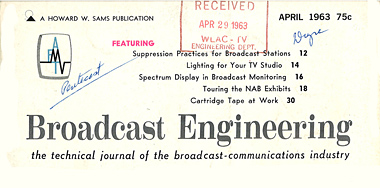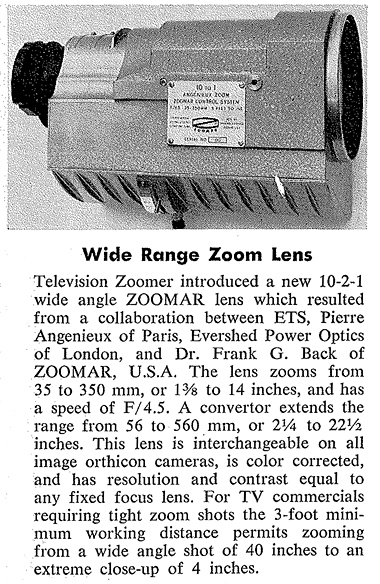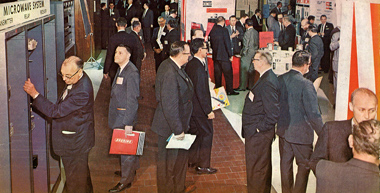A Look Back at Broadcast Engineering Magazine

SPRINGFIELD, VA.—Broadcast Engineering magazine was a long-time favorite of mine, with articles that challenged me to learn more about video technology, and advertising that was often as educational as the articles. I probably saw my first copy in 1980, by which time it was recognizably BE, in a version that looked fairly modern by today’s standards.
The same can’t be said for the two copies of BE that TV Technology’s James O’Neal handed me the other day. Dated August 1962 and April 1963, these two issues provide a fascinating window into the state of television and broadcasting art in the early 1960s.
Starting with the August 1962 issue, the table of contents states that it is Volume 4, Number 8. That means that this was the fourth year of publication, which means that Volume 1 would have been in 1959. Number 8 indicates the eighth month, since BE is a monthly by this point. I do not know if the magazine started out as a monthly, but publishing has a long history of starting out as bi-monthly, then shifting to monthly publication as interest warrants.
The cover on the August 1962 issue trumpets a new series on transistor audio amplifier circuits, which was on page 18. The article, written by Donald K. Haahr from the engineering department at Collins Radio, shows a schematic for a four-transistor push-pull audio amplifier that uses transformers for both the input and output of the final (push-pull) output stage.
Keep in mind that the transistor was still pretty new and something of an oddity in 1962―it had been invented in 1949 and Haahr mentions this right at the top of the article.
“Bell Laboratories began exposing it 12 or 13 years ago and transistors have been in quantity production for the past seven or eight years,” he wrote.
The circuit discussed in the article has its performance shown in a graph that is formatted oddly by today’s standards: The frequency is plotted vertically and the gain (called “dB response”) is plotted horizontally. Those two would be reversed in a modern frequency response chart.
Get the TV Tech Newsletter
The professional video industry's #1 source for news, trends and product and tech information. Sign up below.
Haahr said that he wrote the article to demystify transistors, saying that they were not well understood for two reasons:
1. Many engineers feel the job can be done with vacuum tubes, so why waste time on anything else, and;
2. Lack of understanding makes almost anything complicated.

NAB wrap-up article text for the Television Zoomar 10x lens
Haahr attacked the status-quo of point one directly, pointing out that his employer makes both tube and transistor products that target different broadcast applications.
“For instance, the Collins 12Z2 Remote Amplifier weighs 45 pounds and the transistorized 212Z-1 Remote Amplifier weighs 21 pounds,” he wrote. “The latest model, the transistorized Collins 212H-1 Remote Amplifier, weighs 11 pounds and operates on flashlight batteries at a cost of less than one cent per hour.”
Elsewhere in the August 1962 issue were articles on a new 20 kW FM transmitter from RCA, a news teletype automatic Conelrad alarm, a discussion of proper audio studio maintenance (mostly cleaning techniques), and phase concerns with stereo phonograph records and how that affects stereo broadcasting.
FOCUSED ON RADIO
Nearly all the editorial content in the August 1962 issue of BE is audio-related or focused on radio broadcasting. There is lots of advertising but just a couple (including a full-page ad for Conrac monitors) are for television products. Of course, by the time BE printed its last issue in Oct. 2013, it was virtually all about television.
By the time the April 1963 issue of BE rolled around, there was more television content… at least from an advertising standpoint. In fact, one of the ads was a two-page spread for the Ampex VR-1100 quad video recorder, which the company trumpeted as costing only $35,000. In the ad, the company also said that the recorder’s maintenance costs are low, so companies back then could still promote their products with a wink and a smile!
The highlight of the April 1963 issue was BE’s NAB wrap-up article, which covered three pages. There are definitely some television products on these pages, including a 10x zoom lens for image orthicon cameras. Manufactured by Television Zoomar, the lens was designed by Pierre Angenieux, with an assist from Dr. Frank G. Back of Zoomar.
Other television products in the NAB wrap-up article include a Sony “miniature television tape recorder” that featured the ability to stop and display a single frame. Both GE and EMI/US had film chain systems for television broadcasting, and Mitchell Vinton “…had on display a wide variety of film and television-camera mounting equipment.”

On the floor of NAB 1963
The NAB wrap-up article ― and the magazine in general ― has a good sprinkling of photographs, although the NAB article is really a standout in regard to photography. The technical articles in the issue don’t have nearly as many photographs.
The April 1963’s cover shows a crowd shot at NAB 1963, and it’s notable for two things. First, there are no women in the photo… not one woman among the more than 50 men in the shot. Second, all the men are wearing suits and ties. I guess there was no attending the NAB in a t-shirt, cargo shorts and flip-flops, and exhibitors didn’t have their staffs wearing color-coordinated polo shirts.
There is lots more that could be said about this trip down Broadcast Engineering’s memory lane, but I hope you found this interesting.
Bob Kovacs is the former Technology Editor for TV Tech and editor of Government Video. He is a long-time video engineer and writer, who now works as a video producer for a government agency. In 2020, Kovacs won several awards as the editor and co-producer of the short film "Rendezvous."

